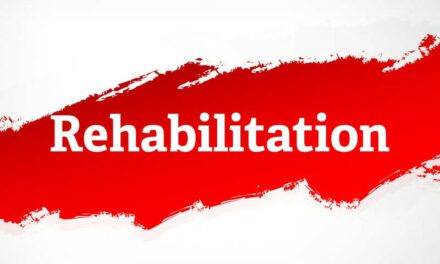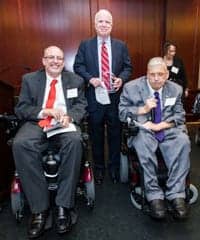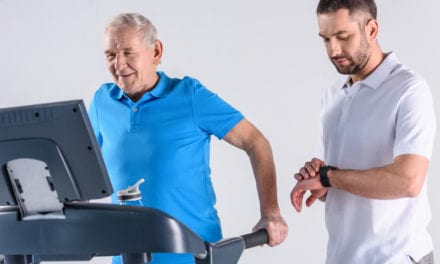
When patients affected by neurological conditions begin therapy in the water, they often regain functional movement quickly.
by Kimberly N. Atkinson, PT, MPT, NCS; Linda Shelburne, PT, MBA; and Cheryl Weixler, PTA
In the United States, there is a high demand for physical therapy and rehab for the millions of people suffering from spinal cord injuries, stroke, traumatic brain injury, epilepsy, ALS, Alzheimer’s disease, and other neurological conditions. At the same time, there are tremendous barriers to working with patients who have become weakened as a result of their medical conditions. Many can only achieve improvement through their ability to make voluntary movements to compensate for involuntary movements that have been compromised. However, standing in the way of progress are other significant by-products of neurological conditions, such as problems with balance, gait, and motor control.
Despite these realities, there are opportunities for physical therapists to help clients recover valuable voluntary and compensatory movements by incorporating aquatic therapy as a primary modality. An aquatic environment is adaptable in a way that a weight-bearing environment is not, especially with regard to buoyancy. For example, up to 90% of a person’s weight is offset by the buoyancy of the water. This is particularly significant in the context of physical therapy, where the properties of buoyancy can reduce a patient’s fear of falling and lower the actual risks associated with falling. Thus, patients of all ages who are recovering from neurological conditions can benefit from having a secure, stable environment in which to regain movement patterns and muscle movement.
Reducing Falls In and Out of the Water
For a patient affected by a traumatic brain injury or Parkinson’s disease, concerns about incurring an injury due to a fall are common problems that must be addressed in therapy. Thus, for the physical therapist working with this type of patient on land, it sometimes becomes difficult to get the individual to replicate normal movement patterns. Instead, the patient may present abnormal movements as a way to attempt to compensate for what they believe could happen (eg, a fall). By getting these patients into the water, physical therapists can facilitate and assist the patient in relearning a more natural gait.
Interestingly, these aquatic therapy behaviors and benefits enhance land-based outcomes. When patients with neurological conditions start in the water, they often regain functional movement quickly. As they become more confident and capable, land-based sessions are integrated into the therapy plan of care. The end-goal of this transitional plan is to help the patient regain maximum functional independence in everyday environments.
Repetition, Locomotion—Key Aquatic Elements
To heighten the ability of a patient to move beyond water-based activity to full-functional land-based activity, repetition of increasingly challenging movements is critical. While this approach is not revolutionary, it does pose an issue when a patient with a neurological disorder fatigues quickly during land-based activity. An aquatic setting provides a therapeutic atmosphere in which an individual can continue to move without becoming instantly exhausted. Consequently, each physical therapy session creates the opportunity to provide increased challenges to balance, dynamic movement, and walking.

Moveable floor technology allows physical therapists to adjust the levels of buoyancy that may be needed for specific types of activities.
Bigger Movements, Better Control
In the Parkinson’s community, LSVT Big has made a huge mark. LSVT Big is based on the theory that a patient with Parkinson’s disease can learn to make big, intentional movements to overcome the small, quick, impulsive movements characteristic of the disease. The process of restoring large movements can be easier with some patients in the water than it is on land. Therefore, many physical therapists with access to therapy pools are integrating aquatic therapy sessions with land-based sessions and seeing tremendous results.
As more research is conducted on LSVT Big and other similar programs, it’s quite possible that other patients with neurological symptoms similar to those experienced by Parkinson’s patients may benefit from the use of LSVT Big. Plus, with therapy pools that are equipped with underwater treadmills and underwater cameras, it’s possible for a physical therapist to provide increased patient awareness and achieve improved patient performance with enhanced quality of movement.
A Neuro Case Study in Overcoming Fear of Water
At the Frazier Rehab Institute in Kentucky, aquatic therapists regularly work with people who have trepidation about being in the water. However, one patient, an older adult male, had a morbid fear of the water stemming from a traumatic childhood experience. Though he recognized that he needed the aquatic therapy benefit, he initially was not able to enter the therapy pool.
To ease his anxiety, physical therapists allowed his daughter to join him during the first few aquatic therapy sessions. By the end of the sessions, he was not only walking without assistance, but had tackled his fear of the water. At that point, his achievements became a “quality of life” success story, not just a neurological physical therapy success story.
For patients who may have special considerations in accessing a pool, there are various models of ADA-compliant lifts that can help provide safe entry and exit from the water. These devices include water-powered, poolside chair lifts suited for in-ground or above-ground configurations. Once in the water, patients can take advantage of other technologies that allow them to participate in therapeutic activities with a minimized risk of falling. Among these are underwater treadmills and resistance jets that can provide new means of strength and resistance retraining.

Pools equipped with underwater cameras help therapists provide increased patient awareness and achieve improved patient performance with enhanced quality of movement.
A Change in Philosophy
As therapy pools become more available at rehabilitation facilities, patients will have more choices when it comes to getting the therapy they need. A better philosophy for any institute serving the public through rehabilitative services is to investigate the way the power of water is changing results for individuals with neurological conditions. RM
Kimberly N. Atkinson, PT, MPT, NCS, is senior director of Spinal Cord Medicine at Frazier Rehab Institute, part of KentuckyOne Health. Atkinson supervises inpatient and outpatient services encompassing the department’s Spinal Cord program, and is director of the NeuroRecovery Network at Frazier Rehab. She has 13 years of experience in the spinal cord injury field.
Linda Shelburne, PT, MBA, is director of outpatient and acute care services, Frazier Rehab Institute.
Cheryl Weixler, PTA, is a physical therapist assistant at Frazier Rehab Institute. For more information, contact [email protected].
References
- Compelling Statistics. American Academy of Neurology Web site. https://www.aan.com/uploadedFiles/Website_Library_Assets/Documents/6.Public_Policy/1.Stay_Informed/4.Public_Policy_Resources/compell.pdf. Accessed July 14, 2015.
- Course Details. LSVT Global Web site. http://www.lsvtglobal.com/big-certification/course-details. Accessed July 14, 2015.





